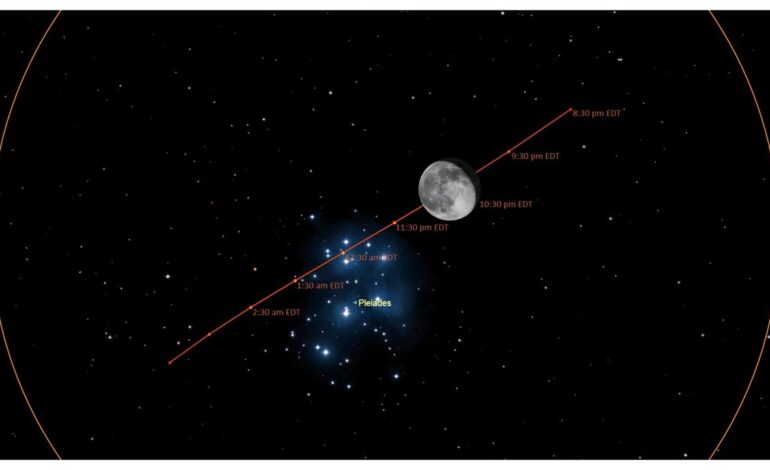Moon to Obscure Pleiades Stars in Celestial Event on October 9

A captivating astronomical event will occur on the night of October 9, 2023, when the moon will obscure several stars in the Pleiades cluster, commonly known as “The Seven Sisters.” This phenomenon, known as an occultation, will provide a rare opportunity for stargazers across North America to witness the moon’s interaction with these celestial bodies.
The moon will be in a waning gibbous phase, approximately 86% illuminated. During the event, stars from the Pleiades will briefly disappear behind the moon’s bright edge and then reappear from its dark side. To fully appreciate this spectacle, observers will need a telescope with a minimum magnification of 50 power, as binoculars may not provide sufficient clarity to follow the stars as they vanish.
Those in the western United States and Canada can begin observing the event during the early evening, with the moon positioned low in the east-northeast sky. For viewers in the eastern United States and Atlantic Canada, the moon will be better positioned, appearing higher in the sky around local midnight. The entire passage of the moon across the Pleiades cluster is expected to last about two hours.
In cities like Chicago, observers can expect to see the moon occult the stars Electra (magnitude 3.7), Taygeta (4.3), and Maia (3.8) at approximately 10:27 p.m., 10:53 p.m., and 10:55 p.m. CDT, respectively. The stars will reappear from behind the moon’s dark limb at 11:20 p.m., 11:38 p.m., and 11:55 p.m. CDT. Notably, the moon will not obstruct four of the seven brightest stars in the cluster—Alcyone (2.8), Atlas (3.6), Merope (4.1), and Pleione (5.0)—but many fainter stars will also be occulted.
Visibility Times and Locations
For those seeking specific visibility information, the International Occultation Timers Association (IOTA) provides detailed timetables for numerous locations. These schedules outline the precise times for the disappearance and reappearance of each star in Universal Time (UT), which corresponds to Greenwich Mean Time (GMT). As the occultation will occur after midnight UT, the relevant dates for local time zones will fall on October 9 for most areas, with exceptions for Atlantic Canada.
For instance, in Denver, Colorado, the star Alcyone will disappear at 4:32:30 UT on October 10. Given that Denver operates on Mountain Daylight Time, which is six hours behind UT, Alcyone will vanish at 10:32 p.m. MDT on October 9. The star is anticipated to reappear at 10:51 p.m. MDT.
In addition to the timetables, a map provided by IOTA illustrates the regions where the occultation is visible. The map delineates various boundaries, with cyan indicating where the disappearance or reappearance aligns with moonrise or moonset. A continuous white line marks the northern and southern limits of nighttime visibility, while blue lines indicate twilight occurrences, and dotted red lines represent daylight.
Future Occultation Events
Occultations of specific stars are regular occurrences, with the moon passing in front of the same stars from different locations on Earth throughout the months. This particular series of Pleiades occultations commenced in September 2023 and will continue until July 2029. Following this series, the moon will move south of the Pleiades until a new series begins in 2042.
After the event on October 9, the next widely visible occultation of the Pleiades across North America will take place on the evening of December 3, 2023, occurring just before a full moon.
Joe Rao, an instructor and guest lecturer at New York’s Hayden Planetarium, emphasizes the significance of these occurrences for both amateur and professional astronomers. He regularly contributes to publications such as Natural History and Sky and Telescope, helping to foster interest in the wonders of astronomy.






